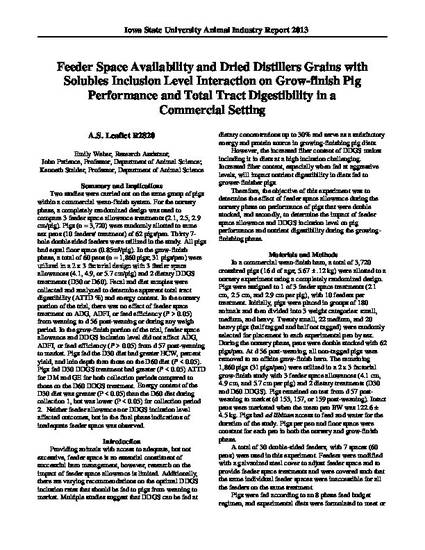
Two studies were carried out on the same group of pigs within a commercial wean-finish system. For the nursery phase, a completely randomized design was used to compare 3 feeder space allowance treatments (2.1, 2.5, 2.9 cm/pig). Pigs (n = 3,720) were randomly allotted to same sex pens (10 feeders/ treatment) of 62 pigs/pen. Thirty 7-hole double sided feeders were utilized in the study. All pigs had equal floor space (0.85m²/pig). In the grow-finish phase, a total of 60 pens (n = 1,860 pigs; 31 pigs/pen) were utilized in a 2 х 3 factorial design with 3 feeder space allowances (4.1, 4.9, or 5.7 cm/pig) and 2 dietary DDGS treatments (D30 or D60). Fecal and diet samples were collected and analyzed to determine apparent total tract digestibility (ATTD %) and energy content. In the nursery portion of the trial, there was no effect of feeder space treatment on ADG, ADFI, or feed efficiency (P > 0.05) from weaning to d 56 post-weaning or during any weigh period. In the grow-finish portion of the trial, feeder space allowance and DDGS inclusion level did not affect ADG, ADFI, or feed efficiency (P > 0.05) from d 57 post-weaning to market. Pigs fed the D30 diet had greater HCW, percent yield, and loin depth than those on the D60 diet (P < 0.05). Pigs fed D30 DDGS treatment had greater (P < 0.05) ATTD for DM and GE for both collection periods compared to those on the D60 DDGS treatment. Energy content of the D30 diet was greater (P < 0.05) than the D60 diet during collection 1, but was lower (P < 0.05) for collection period 2. Neither feeder allowance nor DDGS inclusion level affected outcomes, but in the final phase indications of inadequate feeder space was observed.
Available at: http://works.bepress.com/john-patience/34/
